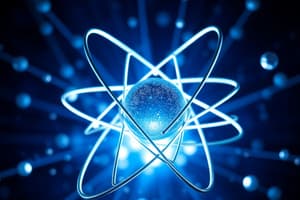Podcast
Questions and Answers
What is the quantum mechanical model of the atom?
What is the quantum mechanical model of the atom?
A model that describes the behavior of electrons in atoms using quantum numbers and probabilities.
What are the four quantum numbers used to describe electrons in atoms?
What are the four quantum numbers used to describe electrons in atoms?
Principal quantum number (n), Angular momentum quantum number (ℓ), Magnetic quantum number (mℓ), Spin quantum number (ms).
What does the principal quantum number (n) indicate?
What does the principal quantum number (n) indicate?
The principal energy levels of an atom.
What shape does the sublevel 'p' correspond to?
What shape does the sublevel 'p' correspond to?
Which element is symbolized by 'P' and has 5 valence electrons?
Which element is symbolized by 'P' and has 5 valence electrons?
Which element is represented by 'He' and has 2 valence electrons?
Which element is represented by 'He' and has 2 valence electrons?
Which of the following principles states that electrons fill the lowest energy orbitals first?
Which of the following principles states that electrons fill the lowest energy orbitals first?
The halogen with the complete electron configuration of 1s2 2s2 2p6 3s2 3p6 3d10 4s2 4p6 4d10 5s2 5p5 is represented by the symbol ______.
The halogen with the complete electron configuration of 1s2 2s2 2p6 3s2 3p6 3d10 4s2 4p6 4d10 5s2 5p5 is represented by the symbol ______.
The Bohr model accurately describes the location of electrons in an atom.
The Bohr model accurately describes the location of electrons in an atom.
What does the Heisenberg Uncertainty Principle state?
What does the Heisenberg Uncertainty Principle state?
What is an orbital?
What is an orbital?
Flashcards are hidden until you start studying
Study Notes
Quantum Mechanical Model of the Atom
- Developed in the 1920s by scientists like Werner Heisenberg, Niels Bohr, Louis de Broglie, and Erwin Schrödinger.
- Introduces the concept of probability to describe electron location, replacing Bohr's planetary model.
- Based on the wave-particle duality of electrons.
Heisenberg Uncertainty Principle
- It is impossible to simultaneously determine both the position and velocity of an electron with complete accuracy.
Bohr's Planetary Model
- Suggested electrons orbit the nucleus like planets around the sun.
- This model was later proven incorrect by the quantum mechanical description of the hydrogen atom.
Erwin Schrödinger
- Developed an equation to describe the behaviour and energies of subatomic particles, incorporating both particle and wave behavior.
- This equation leads to the concept of a wave function, which is proportional to the probability of finding an electron.
- This probability map is a three-dimensional region of space called an orbital.
Quantum Numbers: An Address for Electrons
- Four quantum numbers describe the state of an electron in an atom.
- They can be thought of as an "address" for the electron.
- The analogy is: State (Country), City, Street, House.
Quantum Numbers & Their Meanings
-
Principal Quantum Number (n): Refers to the principal energy levels (n = 1, 2, 3, 4, ...). Higher 'n' values represent higher energy levels.
-
Angular Momentum Quantum Number (ℓ): Defines the shape of an orbital sublevel (s, p, d, f, g). ℓ values are integers ranging from 0 to n-1.
- ℓ = 0: s orbital, spherical shape
- ℓ = 1: p orbital, dumbbell shape
- ℓ = 2: d orbital, more complex shape
- ℓ = 3: f orbital, even more complex shape
- ℓ = 4: g orbital, even more complex shape
-
Magnetic Quantum Number (mℓ): Describes the orientation of an orbital in space. It takes integer values from -ℓ to +ℓ, including 0. Each energy sublevel contains a specific number of orbitals:
- s (ℓ=0): 1 orbital
- p (ℓ=1): 3 orbitals
- d (ℓ=2): 5 orbitals
- f (ℓ=3): 7 orbitals
-
Spin Quantum Number (ms): Describes the intrinsic angular momentum of an electron, which is quantized and has a direction. An electron can spin either up (ms = +1/2) or down (ms = -1/2).
Orbital: An Allowed Energy State for an Electron
- An orbital is a region of space around the nucleus where there is a high probability of finding an electron.
- Each orbital can hold a maximum of two electrons, with opposite spins.
- The term "orbital" also describes the spatial distribution of an electron in an atom.
Studying That Suits You
Use AI to generate personalized quizzes and flashcards to suit your learning preferences.




